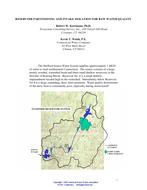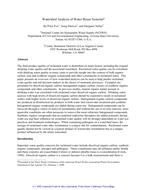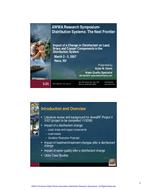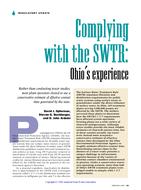Provide PDF Format
AWWA WQTC58863
- Reservoir Partitioning and Intake Isolation for Raw Water Quality
- Conference Proceeding by American Water Works Association, 11/02/2003
- Publisher: AWWA
$12.00$24.00
The Stafford Source Water System supplies approximately 1 MGDof water to rural northeastern Connecticut. The source consists of a large,mostly wooded, watershed basin and three small shallow reservoirs in theflowline of Roaring Brook. Reservoir No. 4 is a small shallowimpoundment located high in the watershed. Immediately below ReservoirNo.4 is a large, expanding, dairy farm operation. Water quality downstreamof the dairy farm is consistently poor, especially during storm runoff episodes. Reservoir No.3 lies approximately two miles downstream of thefarm. Reservoir No.2 is further downstream, and is the direct source of rawsupply water. Significant water quality impacts have been identified,including nutrient and organic loads, high coliform counts, color, metals,turbidity, and bluegreen algae blooms. Water treatment difficulties haveincluded controlling taste and odor, meeting chlorine demands (especiallyduring storm runoff peaks), and the formation of disinfection byproducts.Efforts to identify and implement agricultural best management practices(BMPs) to control runoff quality have progressed slowly due to private landownership and implementation costs.Small, deep water layer aerators (with biological substrates toenhance ammonia removal by nitrification) were installed in Reservoirs No.3 and No. 2. The "indirect impacts" (iron and manganese, ammonia, andsediment P release) related to high organic loads were significantlycontrolled. However, water quality, especially during peak runoff episodes,remained difficult to treat.Reservoir No. 2 (the direct to source of raw water) is a shallowreservoir consisting of two "bays". Roaring Brook (which carries dairyfarm runoff) enters the lower bay, flows through Reservoir No. 2, andleaves either over the dam or through the supply intake. Approximatelyhalf of the reservoir volume and area lie in the upper bay. A narrowconstriction connected the upper and lower bays of Reservoir No. 2. Thewatershed drainage basin which drains directly to the upper bay wasentirely undisturbed woodland. In order to minimize supply water qualityimpacts of agricultural runoff carried by Roaring Brook the intake wasextended to the upper bay of Reservoir No. 2, and a scrim-reinforcedcurtain was used to separate the upper and lower bays of the reservoir at thenarrow constriction. The intent of this reservoir partitioning was to isolatethe water supply intake as much as possible from the impacts of waterquality in Roaring Brook, especially during storm episodes.A comparison of water quality in Reservoir No. 4 (above the farm),Reservoir No. 3 (below the farm), lower Reservoir No. 2, and upperReservoir No. 2, identifies the benefits of reservoir partitioning and intake isolation. Total coliform counts were very high at Reservoir No. 3 andlower Reservoir No. 2 following storms, yet remained low within upperReservoir No. 2.Total phosphorous concentration in surface and over-bottom watersremained lower in the isolated upper bay, compared to the lower bay whichis exposed to Roaring Brook peak flows. Although total phosphorousincreased as the summer progressed, concentrations were lowest in theupper bay. Includes figures.
Related Products
Basic Science Concepts and Applications for Wastewater Student Workbook
Customers Who Bought This Also Bought..
$68.00 $136.00
AWWA RSP64406
Impact of a Change in Disinfectant on Lead, Brass and Copper Components in the Distribution System..
$12.00 $24.00





